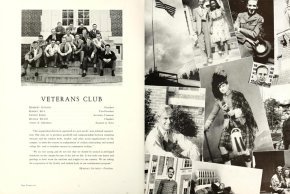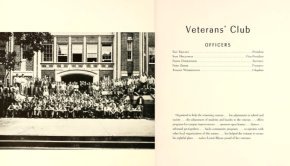
Remembering the fallen, building the future
In fall 1946, a group of returning servicemen gathered on campus with one goal: to build community for the veterans who had come home. “We hope to make life a little easier for the men who served,” one 1946 yearbook entry noted, “and to keep alive the spirit of service that carried us through the war.” From planning social events to fundraising for a recreation center, the newly formed Veterans Club became the heartbeat of postwar campus life.

Beside the flagpoles on Shaw Plaza, a bronze plaque bears the names of Lenoir-Rhyne students and alumni who gave their lives in World War II. Its exact origins are unclear, but the plaque was rediscovered in the Student Life offices in Cromer Center before being reinstalled in its current location. It may date back to the years following the war, when the Veterans Club was active and working to honor those who served.
The 1946 yearbook also includes a memorial tribute to fallen veterans: “We place on record our tribute to those who gave their lives in defense of freedom. They shall live in our memory and in our hearts, as examples of courage and sacrifice.” The message suggests that the club and other campus veterans were actively engaged in commemorative efforts during that period.

The names on the plaque — Augustus L. Arndt, F. Wayne Baxter, Robert L. Caldwell, Percy E. Deveney, Leonard N. Guest, Jay E. Hoffman, Orus B. Johnson, H. Alfred Kistler, Francis V. Lael, John D. Lawrence, Felix A. Little, P. Philip Little, Hugh D. Mashburn, Doyle D. Montgomery, James Priest, R. Stamey Sigmon, Edgar W. Tuttle, John D. Walker, Myron E. Whitener and Glenn Zerden — represent a generation of Bears who made the ultimate sacrifice.
Some were students who traded textbooks for flight manuals, while others were recent graduates stepping away from careers and young families. Their experiences differed — pilots lost over Europe and the Pacific, a sailor remembered in a personal letter from the secretary of the Navy, and servicemen who died in training or while stationed abroad — but each contributed to the fight against totalitarian regimes and left a lasting mark on their communities.

When peace returned, so did a wave of veterans who would reshape Lenoir-Rhyne both physically and culturally, laying the foundation for the modern university. Japan’s surrender in 1945 led to a surge in students taking advantage of government educational benefits provided by the GI Bill®. Enrollment more than doubled, from 407 students in 1945 — consistent with prewar levels despite the absence of many men during the war — to 843 in 1947. By 1955, 224 of the 884 enrolled students were veterans. These returning students brought experience, maturity and expectations that drove changes across campus, from housing and classrooms to athletics and student life.
Housing quickly became a priority. Mapleview Hall, a former private residence across from the library, was converted in 1945 to accommodate 16 men. As enrollment surged the following year, Highland Hall reverted to a men’s dormitory, and 12 prefabricated apartments west of Russell Hall opened in November 1946, giving married students a home on campus for the first time.

The veterans’ presence was felt immediately beyond housing. During the 1946–47 academic year, when veterans made up more than half the student body, the Veterans Club organized events and fundraisers that strengthened campus life. Plans for a dedicated recreation center evolved into a renovated student space in the basement of Yoder Science Building — an early hub for veterans, commuters and staff.
Athletics and campus life revived after a four-year pause in intercollegiate sports. The Piedmont Educational Foundation helped fund scholarships, maintain facilities and expand College Field seating. Campus infrastructure and academics also evolved, with new courses and summer commencements accommodating returning veterans.
The plaque on Shaw Plaza connects these threads — the lives lost and the lives returned. It stands as a reminder that the modern university was built on both sacrifice and service. The legacy of those veterans endures today in the leadership, service and community that continue to define Lenoir-Rhyne.
News & Events

Named Charlotte Mecklenburg and North Carolina School Counselor of the Year, Mena uses her background in mental health and education to strengthen student success and family engagement.
View More
Owens teaches creative writing at Lenoir-Rhyne and has mentored hundreds of student writers. Now he brings that same commitment to his new role as Hickory’s first poet laureate.
View More